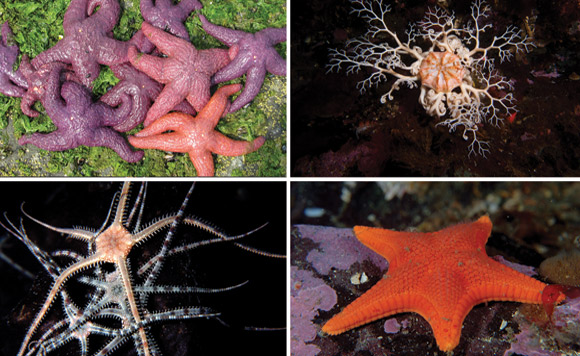– by Tina Kelly –
If we surveyed coastal residents and asked “when you were young, what was your favourite sea creature to find on the beach?” the answer would probably be crabs or starfish – a couple of the invertebrates usually uncovered by the receding tide. Then, if asked how many types of starfish they would recognize, the answer would probably be two: purple and orange.
The purple star, which also has an orange variant, is the most common intertidal sea star (what we now call starfish) along the coast of British Columbia. But you may be surprised to learn that more than 80 sea star species and subspecies inhabit coastal waters from Alaska to Washington. To see the majority of these species, scuba gear or a deep-water submersible is required. If neither of these is at your disposal, the Shaw Ocean Discovery Centre displays numerous subtidal stars in its habitats and you’ll be awed by the variety of colours, sizes and shapes – imagine vibrant orange, hot pink, dusty blue or grey and think webbed arms, skinny arms, branched arms or even 24 arms!
Sea stars, along with urchins, cucumbers and sand dollars, are members of Phylum Echinodermata. In addition to spiny skin (the translation of echinoderm), these species have pentaradial symmetry, an internal skeleton of calcareous plates, the presence of tube feet, and a water vascular system which among other things, moves the tube feet.
Pentaradial symmetry (five spokes) is evident on the purple star but sun stars and sunflower stars can have up to 14 and 24 arms respectively. It doesn’t take a math genius to know 24 is not divisible by five. Sea star species that stray from the five-pointed norm start with pentaradial symmetry and grow additional appendages as they mature. No worries if they lose an arm to a predator: they can simply grow it back!
The incredible ability to regenerate arms is sadly not enough to save stars from the current epidemic of what has been termed Sea Star Wasting Syndrome. Multiple species – including the purple star, pink star, sunflower star, leather star, mottled star and vermillion star – have been affected by this disease that has visually dramatic symptoms including lesions, decaying tissue, deflated appearance and fragmentation of arms. Progression of this syndrome is rapid and death may occur after only a couple of days. The cause is still undetermined but all along the coast from California to Alaska, researchers, divers, citizen scientists and the Centre’s own dive team are helping in the effort to record occurrences, collect samples and help find the answer to what is killing one of our favourite invertebrates.
To submit your own observations of Sea Star Wasting Syndrome, visit http://www.vanaqua.org/act/research/sea-stars
Photo credit (clockwise from upper left): Purple Star (Tina Kelly), Basket Star (Terrance Fidler), Vermilion Star (Wendy Carey), Brittle Stars (Wendy Carey). Tina Kelly is an Ocean Advocate at the Shaw Ocean Discovery Centre. Visit www.oceandiscovery.ca
for more information.




